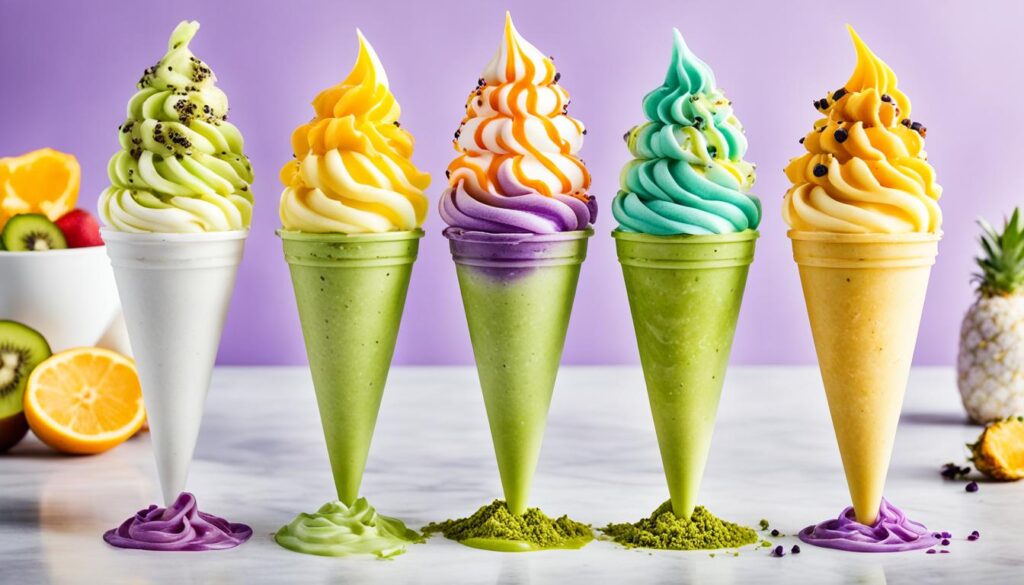Imagine the first warm day of spring after a long winter, the sun shining down, and you standing in line, eagerly anticipating your turn. The sound of the soft serve machine ebbs and flows, creating a melody as delightful as the creamy wonder that awaits you. That moment you take your first bite, the smooth, silky texture dances on your tongue, instantly whisking you back to carefree childhood days filled with laughter and joy. Is soft serve ice cream the ultimate treat for you? With its luscious creaminess and versatility, it beckons both the simple delights and the more adventurous flavors. From classic vanilla to exciting new creations, you might just discover your new favorite indulgence. In this article, we’ll delve into what defines this beloved dessert and guide you in finding the best soft serve dessert for your palate.
Key Takeaways
- Soft serve ice cream is creamy, light, and perfect for warm weather.
- It creates nostalgic memories tied to childhood experiences.
- Diverse flavors and toppings elevate the soft serve experience.
- Premium brands prioritize quality ingredients, health-conscious options, and indulgence.
- Soft serve is more than just a dessert; it can evoke feelings of joy and comfort.
What is Soft Serve Ice Cream?
Soft serve ice cream is a delightful frozen dessert that has captured the hearts of many since its introduction in the United States in the 1930s. This unique treat differs from traditional hard ice cream due to its lighter and airier texture. The key ingredients include cream, milk, sugar, and flavorings, all prepared in a way that entails incorporating air, resulting in a *creamy ice cream* sensation.
Charles Taylor, the inventor from Buffalo, New York, patented an automatic soft-serve ice cream maker in 1926, leading to the creation of this indulgent dessert. Tom Carvel began selling soft-serve ice cream in 1934, further popularizing it. With a milk-fat content ranging from 3% to 6%, soft serve usually has a lower fat content compared to its harder counterpart, which requires at least 10% butterfat.
The air content in soft serve, often referred to as overrun, varies significantly. This variation can affect both the taste and appearance, making it an intriguing option for ice cream lovers. Soft serve can be dispensed in several forms, including fresh liquid, powdered mix, and ultra-heat treated mix, allowing for a range of flavors and textures.

From the unique serving style to its cultural names across the globe, such as Mr. Whippy and Crème glacée molle, soft serve ice cream continues to be a beloved choice for quick, tasty desserts. Each scoop offers a fun experience, combining nostalgia with innovation in the world of sweet treats.
How is Soft Serve Ice Cream Different from Hard Ice Cream?
The differences between soft serve vs hard ice cream center around texture, temperature, and ingredients. Soft serve ice cream features a fluffier texture because it contains a higher air content, typically ranging from 30% to 70%. This overrun gives it a light and airy feel that sets it apart. Hard ice cream offers a denser consistency, with an air content that approaches only 20%.
When it comes to milk fat content, hard ice cream boasts a richer profile, containing between 10% and 18% milk fat. In contrast, soft serve ice cream tends to have a maximum of 6% milk fat. This lower fat level leads to fewer calories in soft serve, making it appealing for those looking for a lighter treat.
Another key distinction lies in the temperatures at which these two varieties are served and stored. Soft serve ice cream is frozen at around -4°C and maintained at about 3°C in serving machines. Hard ice cream is stored much colder, typically at -15°C. This difference in storage conditions contributes further to the contrasting textures experienced when enjoying soft serve vs hard ice cream.
Soft serve is typically dispensed directly from machines which inject air into the mixture, creating its signature texture. Machines like the Gen-5400 Pressurized Freezer and the SLX-500 Gravity Twist Freezer are popular options in many establishments for producing high-quality soft serve. These machines streamline the process, appeal to customer desires, and enhance satisfaction by consistently delivering creamy textures.

Discover the Best Soft Serve Dessert
Soft serve ice cream has captured the hearts of dessert enthusiasts across the United States. Its creamy texture and customizable options make it a beloved choice for a refreshing treat. The appeal of the best soft serve dessert often lies in nostalgia, as many fondly remember enjoying it during childhood outings to local ice cream shops. With a variety of soft serve flavors available, it’s no wonder this delightful dessert keeps drawing in fans of all ages.
Why Soft Serve is a Popular Choice
Soft serve offers an inviting combination of taste, texture, and accessibility. Here are some reasons behind its popularity:
- Variety: Establishments often feature an array of up to six soft serve flavors, including classics like vanilla and chocolate, as well as unique options such as horchata, banana, or matcha.
- Nostalgic Appeal: Many people cherish memories of enjoying soft serve in charming ice cream shops, creating a warm, familiar feeling associated with this dessert.
- Customizable Treats: The ability to create sundaes or banana splits with numerous toppings elevates the experience, allowing for personalized flavor combinations.
Essential Characteristics of Great Soft Serve
A memorable soft serve experience encompasses several key characteristics:
- Smooth and creamy mouthfeel that melts in your mouth.
- Rich and diverse flavor profiles, appealing to various preferences.
- Visually pleasing presentations, whether served in cones, cups, or unique vessels like chimney cakes.
- Availability of dietary options, including dairy-free and vegan variations, allows more people to indulge.
From classic favorites to creative seasonal soft serve flavors, there’s no shortage of options to satisfy your sweet tooth. With many soft serve establishments offering specialty treats and unique combinations, finding your favorite has never been easier.

Delightful Soft Serve Flavors to Try
Soft serve ice cream offers a world of delectable options that can satisfy any ice cream lover’s palate. When you think of soft serve flavors, classic choices come to mind, but innovative options are increasingly capturing attention. Sampling a variety of flavors can enhance your experience, allowing you to discover your favorites.
Classic Flavors You Can’t Miss
Classic soft serve flavors are essential for any soft serve menu. You can’t go wrong with:
- Vanilla
- Chocolate
- Twist (a delightful combination of vanilla and chocolate)
These timeless selections appeal to a broad audience, making them indispensable for soft serve ice cream stands. A scoop of vanilla or chocolate soft serve never fails to evoke nostalgia and joy.
Innovative Seasonal Flavors
Many ice cream shops embrace creativity with seasonal soft serve flavors that reflect local ingredients or festive themes. Some unique flavors to look out for may include:
- Matcha
- Coconut
- Pistachio
- Saffron
- Coffee Cardamom
These soft serve flavors not only elevate your ice cream experience but can also lead to delightful combinations. Visiting a local shop to taste their rotating flavors can be both a fun and rewarding adventure.

The Culinary Science Behind Creamy Ice Cream
Understanding the intricate details of creamy ice cream reveals why it holds a special place in dessert lovers’ hearts. This section dives into the texture of soft serve, exploring its unique characteristics and the key ingredients that enhance its overall creaminess.
Understanding the Texture of Soft Serve
The texture of soft serve ice cream is a significant factor in its appeal. The light, fluffy consistency is achieved through a high overrun of 30% to 70%, which incorporates a substantial amount of air into the mixture, making it less dense than traditional ice cream. Soft serve is typically served at a higher temperature compared to regular ice cream, allowing it to be extruded into that delightful soft swirl.
Compared to traditional ice cream, which has a lower overrun and higher fat content (ranging from 10% to 16%), soft serve feels lighter. This lower fat content combined with the air gives a soft, creamy mouthfeel while providing a delicious, satisfying experience.
The Role of Ingredients in Creaminess
Ingredients play a critical role in achieving the perfect texture of creamy ice cream. The base of soft serve often consists of milk, sugar, and various stabilizers like gelatin or cornstarch, which create that characteristic smoothness. These stabilizers help maintain texture by binding ingredients and preventing ice crystal formation, resulting in a creamier product. Emulsifiers found in soft serve ice cream also contribute to a cohesive mix.
While traditional ice cream relies on egg yolks to add richness and stability, soft serve opts for simpler formulations to maintain its lightness. This focus on air incorporation rather than fat leads to a delightful balance of texture and flavor, inviting you to savor each bite.

| Type of Ice Cream | Milk Fat Content | Overrun | Texture |
|---|---|---|---|
| Soft Serve | 3% to 6% | 30% to 70% | Light and fluffy |
| Regular Ice Cream | 10% to 16% | 20% to 50% | Rich and creamy |
| Super Premium Ice Cream | 14% to 18% | 20% | Dense and luxurious |
| Frozen Custard | 10% or more (cooked) | Less than 30% | Rich and dense |
Popular Soft Serve Places in Your Area
If you’re on the hunt for delicious soft serve, exploring local favorites can be an adventure. Iconic soft serve spots often carry rich histories and community significance, making your treat even more special. In Los Angeles, you’ll discover 14 soft serve spots that delight both locals and visitors alike with unique flavors and styles.
A Spotlight on Iconic Local Favorites
Among the popular soft serve places, some stand out for their creative twists on classic flavors:
- Hokey Pokey: This spot offers a New Zealand-inspired soft serve made with sweet toffee.
- Leopardo: A high-end experience, featuring toppings like rum honeycomb and sourdough Biscoff cookies.
- Fosters Freeze: A beloved classic since 1946, still serving traditional soft serve options.
- Honeymee: Known for its simple soft serve topped with honeycomb, it has expanded to nine locations across the greater LA area.
- Magpies Softserve: This artisanal shop offers made-from-scratch soft serve with inventive flavors, including green tea-brown rice and horchata.
- Bumsan Organic Milk Bar: Located in Koreatown, this spot provides soft serve made with organic Straus milk.
- CVT Truck: A mobile favorite known for classic soft serve in vanilla, chocolate, or twist flavors.
- Big Softee: Inspired by both Hong Kong and American flavors, this spot in Monterey Park is a must-try.
- Little Damage: Famous for its “goth” black soft serve, which broke the internet.
How to Find Soft Serve Near Me
To find soft serve near you, use mobile apps or quick online searches. Entering terms like popular soft serve places or simply soft serve near me can yield delicious results. Check local food blogs or community recommendation sites for updated lists and reviews. With so many fantastic spots, you’re bound to discover a new favorite that brings joy with every cone or cup.

Benefits of Enjoying Soft Serve Ice Cream
Soft serve ice cream presents an array of benefits, making it the perfect treat for any occasion. Whether you’re celebrating a birthday, enjoying a family outing, or simply treating yourself, this delightful dessert brings joy and flavor to every moment. The creamy, smooth texture and fresh taste elevate it as one of the best soft serve desserts you can indulge in.
Perfect Treat for Any Occasion
This sweet treat shines in numerous settings, whether it’s a sunny day at the park or a festive gathering. Its versatility allows for endless variations, from classic vanilla to exciting seasonal flavors. Here’s why soft serve is so appealing:
- Convenience: Soft serve is easy to serve and enjoy, making it a hassle-free option for any event.
- Variety: Your taste buds will never get bored with the possibility of mixing flavors and toppings.
- Affordability: Soft serve options fit a range of budgets, with prices often starting around $6 for a satisfying serving.
Social and Emotional Benefits of Indulging
Sharing soft serve with loved ones can foster connections and create memorable experiences. Treating yourself to the best soft serve dessert has its emotional perks as well:
- Uplifting Mood: Enjoying soft serve ice cream often brings a sense of happiness and nostalgia.
- Building Relationships: Enjoying a dessert together can enhance social bonds and create lasting memories.
- Celebration: Celebrating life’s little joys with a delightful treat contributes to an overall sense of well-being.

Your Guide to Soft Serve Machines
Entering the world of homemade soft serve ice cream can be an exciting culinary adventure. Choosing the right soft serve machine is essential for achieving the perfect texture and flavor. Various factors come into play, including capacity, ease of use, and specific features that meet your needs. Understanding these aspects allows you to make a well-informed decision.
How to Choose the Right Machine
When selecting a soft serve machine, consider the following:
- Capacity: Determine how much soft serve you intend to make. Countertop models usually hold 13-28 quarts, while stand-alone versions can produce 17-32 quarts.
- Type: Choose between gravity-fed and pressure-fed systems. Gravity-fed systems offer a fixed rate of overrun, while pressure-fed systems allow for more control over texture.
- Cooling System: Decide between air-cooled and water-cooled machines. While air-cooled units are easier to install, water-cooled machines are generally more energy-efficient.
Top Brands and Their Features
Several reputable brands offer high-quality soft serve machines. Here’s a quick comparison table to guide your choice:
| Brand | Model | Output per Hour | Number of Hoppers | Cooling Type |
|---|---|---|---|---|
| Taylor | C713 | Up to 20 gallons | 2 | Water-cooled |
| Carpigiani | 182 | 3-8 gallons | 1 | Air-cooled |
| Vortex | ISF2 | 15 gallons | 2 | Water-cooled |

Regular maintenance is crucial for optimal performance. Cleaning the machine components and ensuring the cooling system works efficiently will contribute to a smoother, creamier soft serve. With the right preparation and equipment, you’ll be creating delicious soft serve ice cream that everyone will love in no time!
Soft Serve vs Hard Ice Cream: What’s the Verdict?
The debate between soft serve vs hard ice cream continues to captivate ice cream aficionados. Each type presents its own set of attributes, appealing to various tastes and preferences.
Soft serve ice cream generally contains around 5% milkfat, categorizing it as a lighter option compared to traditional hard ice cream, which typically has a minimum of 10% milkfat. This difference influences not only the taste but also the texture. Soft serve incorporates more air during churning, creating a fluffy feel and a slower melting rate. The result? A delightful treat that feels creamy yet light.
In contrast, hard ice cream is frozen and served at much lower temperatures, around 0°F or below. This higher freezing process creates denser, richer flavors. The classic scoop is also more indulgent, thanks to its higher fat content, which many find satisfying. Premium brands like Ben & Jerry’s emphasize richness and flavor, appealing to those looking for a decadent experience.

When it comes to nutrition, soft serve vs hard ice cream makes for an interesting comparison. Soft serve typically has fewer calories per serving, benefiting retailers with lower production costs while catering to health-conscious consumers. On the flip side, those seeking a traditional ice cream flavor may lean toward hard options that deliver dense, rich satisfaction.
Lastly, trends in consumer preferences highlight ongoing experiments with flavors across both varieties. With brands continuously innovating, you might find unique offerings that blend the best of both worlds. Exploring your favorites could lead to surprising discoveries.
| Aspect | Soft Serve Ice Cream | Hard Ice Cream |
|---|---|---|
| Milkfat Content | ~5% | At least 10% |
| Serving Temperature | 20–25°F | 0°F or below |
| Texture | Fluffy and Light | Dense and Rich |
| Air Incorporation | Higher | Lower |
| Caloric Content | Lower | Higher |
| Common Additives | May include stabilizers | May contain eggs (frozen custard) |
Ultimately, you will discover that there’s no wrong choice in the soft serve vs hard ice cream debate. The best way to find your favorite is to taste both and see which one brings you the most joy!
Is Soft Serve Ice Cream the Right Choice for You?
Choosing whether to indulge in soft serve ice cream involves considering your dietary preferences and restrictions. Whether you have lactose intolerance, follow a vegan diet, or aim for healthier desserts, options are available. An important aspect of understanding what is soft serve ice cream entails evaluating its ingredients and nutritional profile to make informed choices.
Dietary Preferences and Restrictions
If lactose intolerance is a concern, look for dairy-free or vegan soft serve options. These desserts often use non-dairy milk substitutes, allowing you to enjoy the creamy texture without discomfort. Many modern establishments now offer a range of flavors catering to these dietary needs.
Soft serve ice cream typically contains lower milk fat, ranging from 3% to 6%, making it a lighter choice compared to traditional ice cream, which must have a minimum of 10% milk fat per federal law. This lower fat content often means fewer calories, particularly appealing to those mindful of their sugar and fat intake.
How to Enjoy Soft Serve Responsibly
Moderation is key when indulging in soft serve ice cream. While it tends to be lower in calories, it can still contribute to excessive calorie intake if consumed in large amounts or topped with calorie-dense items. Pay attention to serving sizes and opt for smaller portions when possible.
Being aware of the nutritional content will help you enjoy what is soft serve ice cream without compromising your health goals. Consider the following factors when making your choice:
| Factor | Soft Serve Ice Cream | Traditional Ice Cream |
|---|---|---|
| Average Milk Fat Content | 3% – 6% | 10% – 16% |
| Typical Overrun | 30% – 70% | 10% – 30% |
| Calories (per serving) | Lower, varies by flavor | Higher, varies by brand |
| Possible Dietary Restrictions | Dairy-free options available | Limited dairy-free options |

By making mindful choices, you can still enjoy delicious soft serve ice cream while considering your dietary needs. Embrace the lighter options available and savor every delightful spoonful! Many ice cream shops now offer glutenfree dessert options, allowing you to indulge without compromising your health goals. Don’t hesitate to try creative toppings made from fresh fruits or nuts, which can enhance your treat while keeping it nutritious. Ultimately, with a little exploration, you can find the perfect balance between indulgence and mindfulness.
Conclusion
As you delve into the delightful world of soft serve ice cream, it becomes clear that this creamy treat offers much more than just sweetness—it’s an experience filled with joy and nostalgia. Whether you’re savoring a cone on a breezy summer day or indulging in a cool dessert to celebrate a special occasion, soft serve is an ideal choice. The question of what is soft serve ice cream can be best answered by the memories created with each decadent bite, highlighting its status as a beloved indulgence.
Moreover, the versatility of soft serve allows for an extensive range of flavors, making it competitive with traditional hard ice cream. The best soft serve dessert can be customized to meet your preferences, whether you lean towards classic vanilla or adventurous seasonal flavors. With its lower calorie content, smoother texture, and creative serving styles, it’s no wonder that soft serve has established a loyal following among consumers looking to enjoy unique experiences.
So, why not embark on your own journey with soft serve? Explore local shops, try innovative flavors, and don’t hesitate to experiment with mix-ins. Remember to consider your dietary preferences while enjoying this delightful treat. Each scoop can be a step towards discovering your unique bliss, as you find out more about why soft serve ice cream remains a fond favorite for many.









